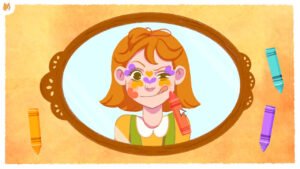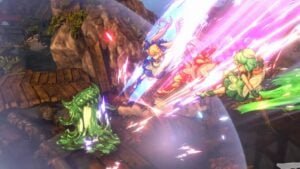CGMagazine had the amazing opportunity to visit SCADFILM’s AnimationFest 2022 in Atlanta, Georgia—where we were able to see and talk to various film and TV animation industry leaders. One of the amazing duos we spoke to were illustrious animation director, Zach Parrish, and line producer, Steven Schweickart, who both worked on Netflix’s The Sea Beast. They were both SCAD alumni as well!
Parrish is best known for his most recent work in animation on Disney’s Tangled, Big Hero 6, Moana and so much more. Schweickart has worked on well-known projects including The Rundown, Elf, the first two How to Train Your Dragon films and more blockbuster hit films and TV shows. Their presentation on the making of The Sea Beast was thrilling to see how their team researched everything about what hunting ships in that era contained—from the details of what the crew members wore on board to the features of the ship design.
It was very interesting to hear about the fact that, “Out of 43 sequences in the film there’s only four that don’t have any water in them,” as Parrish stated on the focus of water for the film. He also included that “one of the hardest things to animate are ropes.” CGMagazine chatted with the two on what their jobs entailed from a production standpoint, the importance of having reference material ready for any animated projects, and what it felt like to create a spectacular animated film like The Sea Beast from home during the pandemic.
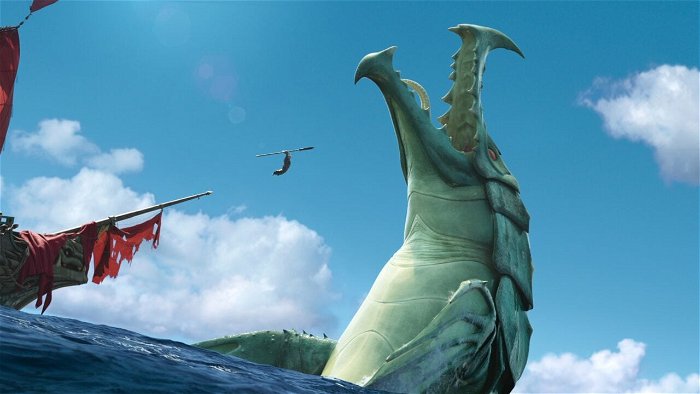
CGMagazine: For someone who does not know what an animation director and line producer does, what does the role entail on a film like The Sea Beast?
Steven Schweickart: For the line producer, there are two producers on our film, the third with our vendor studio, but there’s the creative producer who teams up with the director and interfaces with him. And then, there’s the line producer who sort of interfaces with everyone else in the vendor studio. I also managed the budget, and hired everybody on our side of the fence. And I was the architect for the production schedule. So yeah, the schedule and the budget were my big domains.
Zack Parrish: I was the animation director. That meant I was on the Netflix side. I partnered with the head of animation on the Sony side, which is Joshua Beveridge. And we worked together to try to deliver Chris [Williams], the director’s vision, for the character animation.
That meant we would interact with the rigging departments, modeling departments, the downstream departments to make sure that we were getting what we needed out of the characters specifically. And then we worked with our team of animators, which was 176 animators in total. We led that team to animate their shots. So, we gave them notes to lots of drawbars, acting references, things of that sort to make sure that we got the best performances out of them as possible.
CGMagazine: Wow! That is two very big roles. And do you know about the XR stage opening at the Digital Media Centre? What kind of leaps in technology does this spell for the industry, SCAD and the future of animation?
Zach Parrish: I think the use of AR, VR, XR—all the R’s—especially in the last couple of years, has completely changed how you can make a movie, and the way in which you could pre visualize a movie. Even the scenes in stuff like Mandalorian, and everything Marvel. The way in which you can integrate live-action with real-time game engines, things of that sort, is incredible.
The amount of collaboration that you can have earlier in a process, I think, is really different from kind of the traditional storyboard to layout pipeline. It kind of forces or allows deeper collaboration throughout the entire pipeline very early on, so that everybody is seeing the final product as they’re working.
I think that is such a huge change from where I started in my career, where it was a little bit of a guess-and-check all the way through the process. Which does take a little bit of the fun away. I’ve seen a final render going ‘cool, that’s what it’s going to look like?!’ But I think it kind of pushes where students can take their films, where professionals can take their films and can inspire them to make new decisions as they’re seeing stuff in real time. It’s amazing.
CGMagazine: And I know you, Zach, talked about the challenges of working from home on The Sea Beast. I’m curious if there were some advantages to working from home with the teams for both of you, in each of your roles?
Steven Schweickart: Ah, well, not from my perspective. I mean, some people really like working from home. The advantages, you could get to spend more time with your family and your pets. That would be the advantage. But outside of that, I felt it was more of a hindrance. I would prefer to be in a room. But the thing that was the biggest advantage would be that we get to work with artists around the world.
But to make an entire film from home again, would have to be under dire circumstances. Because of the pandemic, you lose that shorthand that you have when you’re in a room with someone. You also lose your ability to read, like physical cues and emotions properly. So, from a producer’s standpoint, I would prefer not to do it again. But that’s not to say that I don’t enjoy working with new artists. I get to work with artists in Spain; I get to work with artists in France; and in Taiwan. So, I do appreciate that part of it.
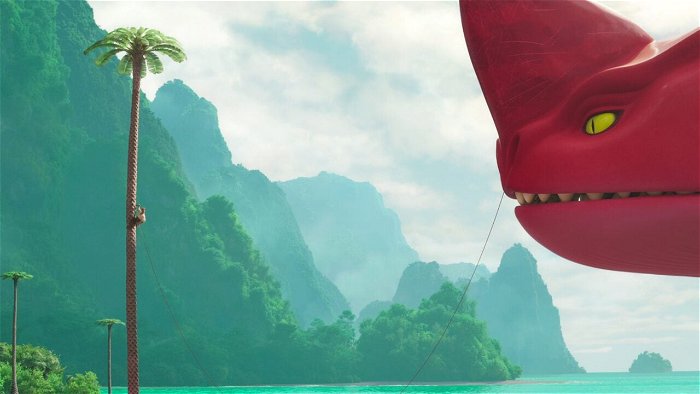
Zach Parrish: Yeah, I think that’s well said. I think the advantage is the flexibility. If there’s a silver lining to be found in all of this, I had a daughter at the very beginning of working on this movie. And so, I got to be there, which was a huge, huge silver lining to a very bad situation. And it also, like I said in the presentation [earlier in the day], made things a bit more personal. When you’re in each other’s homes, you start to remember that people are people.
However, the longer you talk on a Zoom call, the more somebody can turn into just a face. And I think that is the fear that I would have of doing a full movie like this again—it does take some of the personal-ness out of it. Not just the ease of conversation, but remembering that humans are humans. Seeing their homes helps, but it also kind of detaches you from them. But I think the biggest win overall is globalization of the industry talent of the talent.
Steven Schweickart: Yeah. But like I would walk into my office space that I had set up in a spare bedroom at eight, and I would not leave some night days until like nine or 10 that night. So, it was gruelling.
Zach Parrish: A lot of my garage. Yeah. But I mean, from a technical standpoint, the fact that all these companies, Imageworks was set up, they had kind of worked in a way that allowed them to be remote already. So, The Sea Beast in particular was able to get up on its feet fairly quickly when the pandemic hit. But all the companies who have had to adjust since now can offer a more flexible schedule.
I think that is a huge advantage going forward that people… it doesn’t have to be one or the other. It can be a hybrid, and you can work from home if you need to work from home, or you can work from Spain if you need to work from Spain. And having it not be binary, I think is huge.
CGMagazine: Delving more into The Sea Beast, so you talked about all the reference and research that went into things like the ship design. I was curious about the references to the spears, the use of spears, which were used for a lot of purposes in the film. Where did the reference come from for the spears?
Steven Schweickart: Well, Matthias [Lechner] pulled from real life reference which is a key to immersing the audience in the world. They used lances and spears they actually used on whale hunting ships. So, they were based on that with some liberties taken for style and appeal, but they were based on real tools that whalers used.
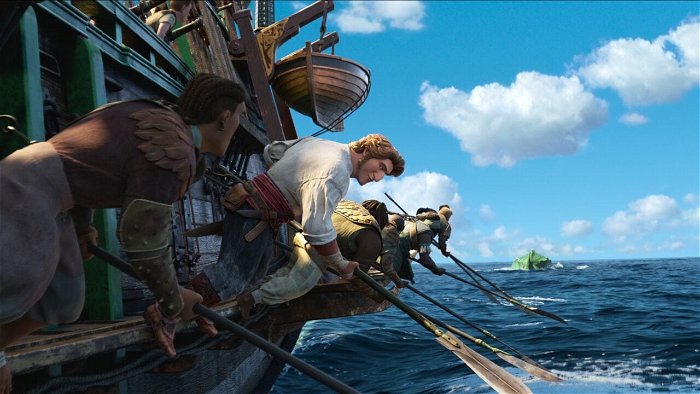
CGMagazine: I know someone asked yesterday about the designs of Red and the sea beasts, but were they based on mythological creatures like the Kraken and the Megalodon?
Zach Parrish: We kind of drew from different references. I think the one we talked about the most is Red because of her importance to the film. I know there were a lot of references used, but lions were one of the main animals used because Chris would often use the word ‘regal’ to describe Red. She’s the biggest; she’s the scariest; she’s the queen; she rules.
And so, making sure that she has that air about her in her animation but also kind of the mystique about her design. The simplification of the planes of her face and things like that. She is also aerodynamic…no not…aerodynamic. Chris said it all the time. I can’t remember the word.
Steven Schweickart: Naval dynamic? [Whole room burst out laughing.]
Zach Parrish: She can glide through the water, right? I mean, you look at whales and things like that—
Steven Schweickart: Aqua-dynamic?
Zach Parrish: Aqua-dynamic? Maybe. But yeah, there was a lot of references to whales and different types of sea creatures. From an acting standpoint, it really came down to what the shots called for. We would reference gorillas for how she might walk. We referenced whales and dolphins to some degree for how she might glide through the water. It was kind of all over the place.
But then there’s also other giant creatures in the film, there’s the giant crabs and things like that. There’s the Brickleback at the beginning, the green monster at the beginning of the film, that we were pulling all kinds of references to alligators. It really came down to what the shot was trying to do. And what purpose, story wise, it was trying to serve.
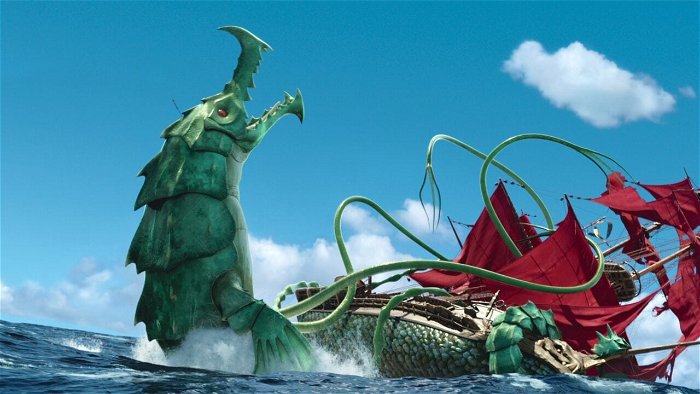
CGMagazine: One of my personal favourite scenes in The Sea Beast was when Jacob and Red were having a scuffle, and then a giant crab interrupts them. And it was almost like a big kaiju fight, was kaiju fighting what y’all were going for here?
Zach Parrish: I know we talked about kaiju a lot, just because of the sheer sense of scale. We talked about Ray Harryhausen films. We’ve talked about all kinds of stop-motion, live action, visual effects, films, going way, way back. One of Chris’s favourite films to reference from a character standpoint, but also from a scale standpoint, is the 1976 King Kong [film].
There’s a lot of references, and Josh Beveridge, our head of animation, was like the reference king. He had this entire arsenal of references that he had categorized, and he could search and pull up. Whenever we were talking about a particular movie, he could usually pull up that scene. We definitely had a lot of kaiju movies that we looked at, because again, just trying to make sure that we had that sense of weight and scale.
CGMagazine: I know, you talked a lot about the water effects with the Buoy System yesterday. But I was curious about the various shades of water and how that was achieved, like in the first scene with young Jacob or when Captain Crow was being pulled down underwater?
Zach Parrish: Yeah, I can’t speak to that.
Steven Schweickart: Yeah, that was all based on the colour script designed by our production designer, Matthias Lechner. But also, the rendering team at Sony Imageworks. They’ve been doing it for decades. But the design of the colour and the colour differences, that’s all Matthias and Woonyoung [Jung] when they developed the overall colour scheme.
Zach Parrish: Yeah. And our VFX supervisor, [R.] Sterling Duguid was amazing at getting his team to develop the shaders necessary to make it feel believable and grounded, while also using the lighting system to execute that. It really was kind of a one-to-one match.
Steven Schweickart: When we embarked on this film, the water was the thing we were most scared of. And then it turned out to be the thing that we didn’t have to worry about because Sony was so on top of it, led by Spencer Lueders. They just developed a water system and they made movies like The Perfect Storm. And you know, this wasn’t their first rodeo.
Zach Parrish: Or the animated movie, Surf’s Up.
Steven Schweickart: Yeah, they’ve made a ton of movies with a lot of water. But I have to say, I haven’t seen better water from any studio. So, hats off to Sony and I really hope they get a lot of awards.
CGMagazine: Yeah, that makes sense. Because for me, the reference was more with a game called Sea of Thieves, which had amazing water graphics.
Steven Schweickart: I have heard of it. Yeah, I remember our head of story, Owen Sullivan came up to me and he pulled up Sea of Thieves. This was way early on in 2019. And he’s like, ‘can you please just promise it looks at least this good?’ And I was like, ‘Dude, you have no idea. So much better. Then, he gave me a fist bump and it came true.
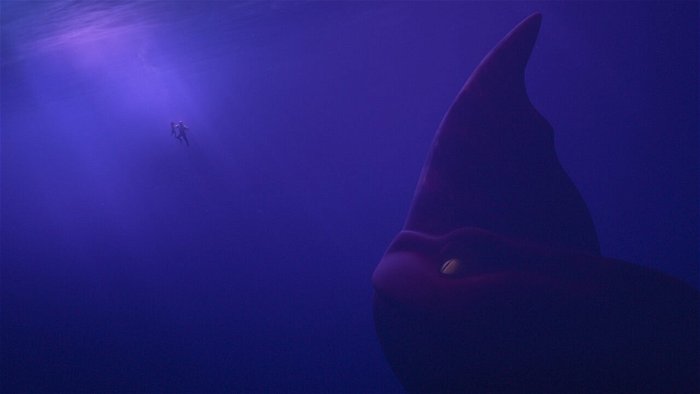
CGMagazine: As both of you are alumni, what is one non-teachable piece of advice you’d give to aspiring animators or producers, studying here at SCAD or abroad?
Zach Parrish: The thing that I will usually say to students, that is not necessarily something you learn in class, is to get out and live. It’s sort of an anti-lesson to some degree because what you’re doing is you’re making art. And in order to make art, you have to have an opinion. Art is an opinion on the world, and it is a reflection of an opinion on the world. And you have to understand your opinion on the world. And in order to understand your opinion on the world, you have to have experienced that world and to be conscious of the experiences that you’ve had, especially at SCAD.
At any of the campuses, you’re in these amazing cities, with amazing art, architecture, people and nature. You can get out, and you can experience things, and you can start to pull references that you will use in your art. Yes, it can be about needing to learn about how to and where to click in the software, or how to draw the thing. But then, you start to lose focus on the point of art in general. And I do think that’s an incredibly important piece of being an artist. And having an opinion.
Steven Schweickart: It’s funny because when I was an actor, that was my training as an actor. That’s what they told me too; live your life. Otherwise, you’re not going to be able to provide a good performance. For me, it would be to stay open. To do everything, don’t pigeonhole yourself like I’m only going to be an animator, I’m only going to be this.
Stay open and flexible in that regard. But also, never give up. Never stop. Keep trying. If you feel like it’s taking you too long to meet your goal, don’t give up. You just got to keep going because persistence is everything. As long as you stay persistent, you will achieve your goals.
The Sea Beast is currently available to stream on Netflix.


